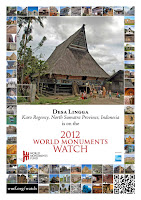THE WORLD MONUMENTS WATCH
Launched in 1996 and issued every two years, the World Monuments Watch is the flagship advocacy program of World Monuments Fund. The Watch calls international attention to cultural heritage around the world that is at risk from the forces of nature and the impact of social, political, and economic change. From archaeological sites to modern architecture, cultural landscapes to historic urban centers, the Watch identifies places of significance in need of timely action. Th e 2012 World Monuments Watch continues this tradition with the inclusion of 67 sites from 41 countries and territories.
In its sixteen-year history, the Watch has served as a beacon, not only for treasured places but for society as well. As an open process, the Watch receives nominations directly from individuals, organizations, and governments on the ground. More than 500 advocates in over 80 countries engaged in the preparation and endorsement of nominations to the 2012 Watch, raising local issues to inform an international dialogue.
More than ever, this ninth cycle of the Watch underscores the important dynamic between communities and their collective heritage. Th e 2012 Watch includes many sites from urban, densely populated areas, which highlight the growing need to balance heritage preservation with the demand to serve contemporary social, economic, and environmental priorities. The 2012 Watch continues to highlight the need to protect the heritage of the recent past, as well as the challenges faced by archaeological sites that increasingly need improved management and visitor plans. Th e 2012 Watch is an opportunity to discover many places that are jewels hiding in plain sight or found in remote areas that may be enjoyed by only small numbers of local residents and adventurous travelers. Just saving sites from destruction or decay is not enough. Conservation means working to integrate heritage into the fabric of society and reconnecting people and places in new and innovative ways.
The 2012 World Monument Watch encourages everyone to do the same. Do your part to make the past part of a better future by supporting activities at 2012 Watch sites, joining local advocacy efforts, or just passing on the message. For more information, go here.
Located outside of Kabanjahe and west of Lake Toba in central North Sumatra, the farming village of Desa Lingga is emblematic of the challenges of maintaining local culture and vernacular practices in a rapidly globalizing world. Decorative timber structures with graceful thatched roofs characterize the village and are vestiges of traditional Karo Batak design and construction. In the mid-1980s, 28 of these dwellings were surveyed; now only nine remain. Many have been replaced with modern, concrete block housing. Of the surviving structures, three have been restored with local resources and know-how, and six are in desperate need of repair.
 A community crafts program was established to fund restoration efforts over the past two years, but diminished tourism has decreased revenue and thus impeded repairs. A tornado that passed through the village in April 2011 further damaged the already compromised structures and stretched limited resources. Little time is left before several of these houses succumb to decay and collapse. Desa Lingga represents a timely opportunity for international cooperation in preserving local heritage and in preventing the loss of an important example of vernacular architecture of southeast Asia. Go visit!
A community crafts program was established to fund restoration efforts over the past two years, but diminished tourism has decreased revenue and thus impeded repairs. A tornado that passed through the village in April 2011 further damaged the already compromised structures and stretched limited resources. Little time is left before several of these houses succumb to decay and collapse. Desa Lingga represents a timely opportunity for international cooperation in preserving local heritage and in preventing the loss of an important example of vernacular architecture of southeast Asia. Go visit!Since 1996 Indonesia has some site were on World Monuments Watch. They are Borobudur, Central Java (1996); Tanah Lot Temple, Beraban (2000); Omo Hada, Nias (2000, 2002, 2004, 2006), Omo Hada is a rare surviving 18th-century traditional Indonesian village; Tamansari Water Castle, Yogyakarta (2004), Tamansari means perfumed garden, is the name for the gardens and associated structures built in 1765 for Hamengku Buwono I, the Sultan of the kingdom of Yogyakarta; Kotagede Heritage District, Kotagede (2008) and current watch site is Desa Lingga, Karo Regency, North Sumatra. Nice, isn't it?
